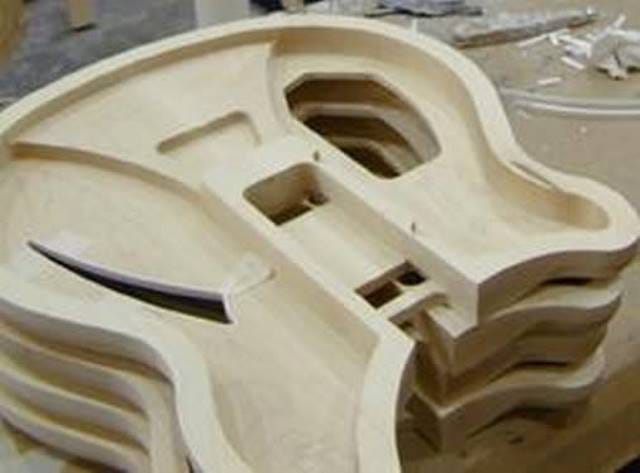Terminology: X-Bracing
One of the terms you’ll run across again and again on the forums is “x-bracing”. And you may ask yourself “what does that mean and why should I care?” Those are good questions, so let’s answer them!
We’re gonna start with “what exactly IS x-bracing?” Well, this picture of the “guts” of a 1966 360 should make it pretty self-evident:

So let’s just do a quick refresher of how Rickenbacker’s “semi-hollow” bodies are made. Very importantly, they are NOT made like an acoustic or hollowbody guitar is made, where the top, back, and sides are all made independently and then assembled. In this case, a body blank is made by gluing two (three up until late 1966!) blocks of solid maple together side by side. The body shape is cut from this blank and then routed out from the rear to create what you see above. So the front and the sides are made from “one piece”. You can see where the neck tenon slides into place, and then a solid back is glued on to hold it all together.
The picture above makes WHAT x-bracing is very clear: added braces, in an “X” shape. So WHY add the x-bracing? There are two basic reasons. The first is to provide some rigidity to the top. While it is thicker than an acoustic/hollowbody guitar’s top, it can still warp over time and the bracing combats that.
The second is reason is to add some structural strength to the guitar by connecting the top to the back in the guitar’s weakest area—right there in the middle—to keep the top from sinking and to make “crushing” more difficult.
Around 1984 the bracing changed. Rather than hollowing out the entire body and then going back and gluing in bracing, the bracing became an integral part of the structure.

As you can see, right there in that crucial center section material from the original body blank is left intact to do the same job(s) as the old x-bracing. So that’s the what, why, and when. Why should you care?
Well, here’s where facts and opinion—compounded by a couple related but different factors—kind of collide. First related factor: top thickness has varied over time—from a low of around 1/8” to a high of around 3/8” (3.2mm-9.5mm). If you were to plot it out, they were thinnest in the 50s and 60s, thickest in the late 70s and early 80s, and got a little bit thinner starting in the late 80s.
So the facts are we have thinner tops with x-bracing in the 50s and 60s, thick tops with x-bracing in the 70s thru mid 80s, and kinda in-between tops with integral bracing from the mid 80s on. Which is best?
That’s where opinion enters in. The thin top/x-bracing guitars ARE the most resonant acoustically. That’s just physics. Does that make them better? It certainly makes them “different”. The thick top x-braced guitars ARE the heaviest. Does that make them worse? Here’s where opinion enters the chat. To me, thick top guitars with button top Higain guitars—and pickups are the second compounding subject!—are just magical. But that’s just, like, my opinion, man. Plenty of folks hate those guitars—thin tops or die! I’d summarize the argument by saying if you like a very bright guitar, you’ll likely prefer the thinner tops. If you like it a bit heavier, go thicker.
Two guitars in the line today actually have x-bracing: the 360/12C63–which makes sense as a reissue model—and the 1993 Plus. Which kinda surprised me when I first heard it, but also kinda makes sense—they’re using the same basic template for both guitars. That said, the x-bracing in use is akin to the modern bracing in that it is carved in place rather than added afterwards.
I should also mention that the 6/12 “convertible” 336/12 and 366/12 had an extra bracing block inside the guitar directly below the converter mechanism to provide some additional reinforcement.
So now you understand what all the fuss is about x-bracing. Want to learn more about…everything else? Check out the rickenbacker101 site map and see what’s already been covered! Have a suggestion about what we should tackle next? Drop it in the comments and we’ll add it to the queue.


Always appreciate learning something new and interesting about Ricks.. Thanks :)
When you say, "Two guitars in the line today actually have x-bracing.." are you sure about that? I think that they switched to x-bracing at the same time as they switched to 21 frets. My 2024 360 has x-bracing and wasn't sold to me as anything special, they just said that this was the new standard for all 330's and 360's.